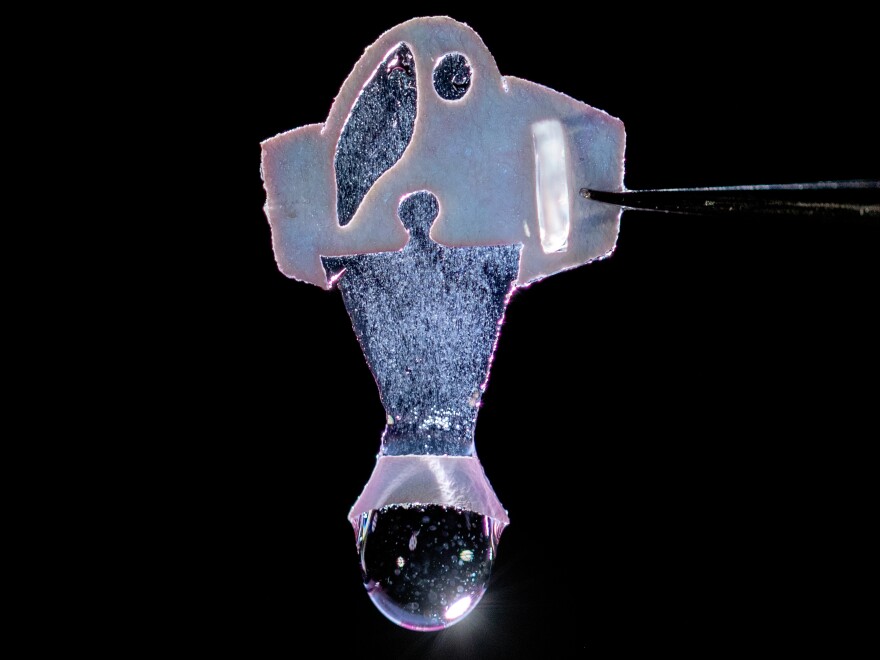Scientists have built a school of robotic fish powered by human heart cells.
The fish, which swim on their own, show how lab-grown heart tissue can be designed to maintain a rhythmic beat indefinitely, a team reports in the journal Science.
"It's a training exercise," says Kit Parker, a professor of bioengineering and applied physics at Harvard. "Ultimately, I want to build a heart for a sick kid."
The tiny biohybrids, based on zebrafish, are built from paper, plastic, gelatin and two strips of living heart muscle cells. One strip runs along the left side of the robot's body, the other along the right.
When the muscle cells on one side contract, the tail moves in that direction, propelling the fish through the water.
The movement also causes the strip of muscle cells on the opposite side to stretch. This stretching, in turn, produces a signal that causes the cells to contract, which perpetuates the swimming motion.
"Once that cycle starts, these things just start motoring," Parker says.
The fish are equipped with a special cluster of cells that initiate the cycle of stretching and contracting, Parker says.
The robotic fish were assembled by a team of scientists including Keel Yong Lee of Harvard and Sung-Jin Park of Emory University and Georgia Tech.
The team tested some early samples by artificially activating the muscle cells, Park says. Then they put the leftover fish in an incubator and forgot about them for a couple of weeks.
When they finally opened the incubator, "all the fish were swimming by themselves," Park says.
The fish kept swimming for more than three months, sustained by nutrients added to the fluid around them.
When it came time to sacrifice the little swimmers, the scientists felt sad, Park says. "We have a kind of emotional attachment to the fish."
From synthetic fish to healing hearts
Showing that it's possible to produce human heart tissue that beats on its own is important because the body can't replace heart cells lost to disease or inflammation.
"Once you're born, about two days after you leave the womb, the number of cardiac muscle cells you have then is all you're going to have for the rest of your life," Parker says.
The team chose to test its lab-grown heart cells in robotic fish because of the similarities between swimming and the pumping action of a heart, Parker says.
In some ways, a fish is a pump, he says. But instead of pumping blood through the body, it pumps itself through the water.
"I really believe that there's a common design scheme, there's some fundamental laws of muscular pumps that are conserved from marine life forms to the human heart," Parker says.
In 2016, Parker's lab built a stingray powered by rodent heart cells. They used light to control the cells in a way that caused the robot's fins to undulate, propelling it through the water.
This time, his team used stem cell technology to transform human skin cells into cardiac muscle.
"The really interesting thing about these fish, which we weren't expecting, is how long they would swim and how fast they would swim in the dish," Parker says.
Heart cells stay health by constantly rebuilding themselves, a process that takes about 20 days, he says. Because the fish swam for more than 100 days, he says, "each cell has rebuilt itself in there about five times."
The muscle cells also became stronger with exercise the way cells in a human heart do. This suggests the cells could eventually be used to repair a failing heart.
What lies ahead for biohybrid bots
For now, though, this sort of research should help scientists understand how the heart works and test drugs for problems like heart failure, says Ritu Raman, a mechanical engineer at MIT.
"You really need to know how is something built in the native context, and how can we recreate that in the lab as closely as possible," Raman says.
Raman's own lab has produced robots powered by skeletal muscle, including one that could recover from an injury.
"This robot would get damaged and then we would heal it, and after a couple days it was able to move and walk around just as it had before," she says
Robots powered by living cells have raised questions about whether scientists are blurring the lines between machines and living creatures.
But those lines are still pretty clear with today's robots, Raman says. For example, they lack awareness and can't reproduce.
"All you're really doing is replacing an engine or a rotor or another piece that you would make in a machine," she says, "so I would not consider them living beings."
But as biohybrids become more sophisticated, Raman says, they may merit the same ethical consideration given to animals.
Copyright 2023 NPR. To see more, visit https://www.npr.org.



